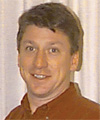Keynotes and Invited Talks
AmI-07 features several top speakers from research and industry.
 |
"Make IT Matter"
Gregory D. Abowd
Professor, School of Interactive Computing & GVU Center
Georgia Institute of Technology
Where has ubiquitous computing come since the early visions of Mark
Weiser? Well, for one thing, it goes by a lot of different names.
But despite the abundance of names, to me we are all seeking the same
vision. Or are we? In this talk, I would like to give you my take on
why <insert your favorite name for ubiquitous computing> is an
interesting and important field of research. I will also try to
explain the title of this talk (Make IT Matter) and why it represents a
philosophy on the style of research one can do. In short, I think we
all need to step back and assess why it is we work in this area and
what we hope to be the legacy of our accomplishments. I'll give you my
opinions (obviously) but what I really hope to do is to spur you to
think about the answers for yourself.
|
 |
"Experiments in integrating the physical and digital"
Patricia Maes
Associate Professor
MIT Media Laboratory
There is a huge amount of useful information available online about
everything around us: the objects we handle, the people we meet and
the places we frequent. However, to access this information we have
to completely interrupt what we are doing to use a keyboard, mouse
and browser on either a computer or mobile phone. This tends to be
very disruptive and time consuming, and as such we do not usually
consult this relevant information while on the move. In this talk I
will document a series of experiments underway at the MIT Media
Laboratory that try to integrate relevant information & services
more closely into a user's physical environment, thereby allowing a
user to combine the affordances of the digital and physical worlds
in one and the same experience.
|
Invited Talks

|
"Ambient Computing and the Disappearing Computer"
Norbert Streitz
Senior Scientist and Strategic Advisor
Fraunhofer IPSI
"Ambient Computing" constitutes the next phase of creating environments
where the "the world around us" is the "interface" to information and
for communication and cooperation. A major aspect is the rapidly
increasing trend of embedding computation in everyday objects creating
"smart artefacts" and the notion of "The Disappearing Computer". At the
same time, this raises new challenges and problems (e.g., privacy)
for the design of "smart" environments that react in an attentive,
adaptive, and active (sometimes proactive) way to the presence and
activities of humans and objects when providing, e.g., socially aware
services.
Adopting the notion of the "disappearing computer", the goal is to hide
the presence of technology from users, by providing implicit, unobtrusive
interaction paradigms. Despite involving a large variety of technologies,
people and their social situations, ranging from individuals to groups,
be them work-groups, families or friends and their corresponding
environments
(office buildings, homes, public spaces, etc) should be at the center of
the design considerations. This talk will present and discuss different
design dimensions and examples of corresponding smart environments.
|

|
"Toward Seamless Interaction in Information Environments"
James "Bo" Begole
Ubiquitous Computing Area Manager, PARC CSL
http://www.parc.com/research/subtheme.php?subtheme=Ubiquitous+Computing
The early vision of Ubiquitous Computing is no longer a dream but an
all too ubiquitous problem. Yesterday's vision of widespread
computation, information, media, and communication has become a
reality today where managing and controlling these many types of
information services, devices, and applications is becoming
impossible, especially as the user interfaces and interaction
techniques for each become increasingly divergent. Today's
technological reality also creates opportunities for new kinds of
applications and services that not only augment the immediate
physical experience but also integrate information across the
"virtual" and "real" aspects of one’s life.
The overarching goal of PARC's research in ubiquitous computing
today is to achieve an environment of "seamless interaction" –
where people control information environments as a seamless whole
as opposed to managing collections of networked components. We
take a three-front strategy toward this objective: 1) lightweight
"at-hand" interaction techniques and systems that react to implicit
user actions, 2) infrastructures and platforms that reduce
technical boundaries, and 3) user behavior modeling to anticipate
user goals and adapt systems to user needs. I'll describe several
projects in these research thrusts and reflect on some of the
lessons learned for user-centered methods for the design of
pervasive, behavior-based applications.
|

|
"Ambient Intelligence in the Internet of Services"
Lutz Heuser
Vice President Corporate Research
SAP
During the past few years, the Internet has become one of the most important media for communication and information. Most Internet users consume and retrieve static content that someone else provides and maintains. They also use simple communication services of various patterns, such as e-mail, instant messaging, and blogs. To navigate in this digital universe and find relevant information, people often use search engines with keyword search functions, which - combined with paid-for advertising - have established themselves as the most successful business model on the Internet so far.
Behind the vision referred to as the "Internet of Things" and the "Internet of Services", we see novel technologies and applications that are as much part of the next-generation Internet as the interactive technologies already in use today, such as mashups and blogs. These innovations will again fundamentally transform the Internet – and, in turn, the economic and social environment – because they will make it much easier to manage and display data on the Internet and also reflect more closely what is happening in the real world.
Thus, I am looking forward to talking to you about some of the following questions:
What is the role of IT and Software-Oriented Architectures in that game? And what is the vision of the global player SAP with regards to this so-called "Internet of Things" and "Internet of Services"?
|

|
Emile Aarts
Vice President and Scientific Program Director
Philips Research
|
|
|

